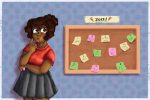Despite the daily horrors that grace our news feeds these days, for those, like me, who are lucky enough to be able to stay safely at home, the general consensus is that a global pandemic turns out to be crushingly boring. As we all grope for productive activities to fill up the hours that would otherwise be spent in a fugue state of existential dread, the suggestion of learning a language has become increasingly popular.
With largely inadequate foreign language education in many high schools and even universities, the burden of learning a foreign language falls on the shoulders of the individual in American society — but this same lack of education means that most individuals have no idea where to start, even with all the time in the world.
That’s where Duolingo swoops in. The free language learning app currently offers courses in 36 languages for English speakers, three of which are in beta, and two of which — High Valyrian and Klingon — are fictional languages. Each course consists of a “tree” of skill modules, each of which teach you a few new vocabulary words and perhaps a new grammar point or two through translation and dictation exercises.
The learner must practice a particular skill module many times in order to complete the module, turning the icon gold. Even after completing a module, the learner must occasionally review the module after a specified number of days in order to keep it gold.
Because each bite-size lesson only takes about five to 10 minutes to complete, Duolingo can seem like a less intimidating way to begin studying a language. The learner can easily wedge their language practice in between any other pressing tasks, and the app does its best to make practicing gratifying by providing the user with a streak representing all the days the user has continuously used Duolingo, which serves as an indicator of clout on the app’s discussion boards.
There’s only one problem with this model, and it’s a whopper: You will never be able to learn a language using Duolingo. There are several reasons for this, the first being that most Duolingo courses don’t actually teach all that much of a language. The app’s design is nominally based on the Common European Framework of Reference for languages, which encourages a conversational approach to teaching language with six different levels — A1, A2, B1, B2, C1 and C2 — all based on what the learner is able to achieve with the language at those different levels.
Most Duolingo courses only teach up to A2, the level at which the learner should be able to communicate about basic everyday tasks and their background — where they’re from, their family, how they learned the language and so on.
The key word for the CEFR is communication, but since Duolingo offers zero opportunity for learners to communicate with native speakers or even other language learners in the target language, even the claim that the app can teach up to A2 is somewhat dubious. And communication — especially speaking and listening — is absolutely essential both for language learning, and for achieving the eventual goal of using the language to speak with a fellow human.
Our brain has two different memory systems that are involved in language learning, known as the declarative system and the procedural system. The declarative system stores idiosyncratic information and individual facts, while the procedural system stores information that fits into patterns, sequences or rules. The declarative system holds the fractured bits of information, and the procedural system pieces them together into a beautiful mosaic of understanding.
The declarative system learns very rapidly, with as little as a single exposure to information, while the procedural system requires long-term, repeated practice, which will eventually lead to more automatic processing of information. In other words, when you speak your native language, it’s your procedural system that’s putting in all the work.
On the other hand, when you learn a language using Duolingo, your brain stores most of the information in the declarative system because you’re only practicing for a short period every day, and the information you’re learning is not reinforced by any other form of input or output.
The repetitive nature of the exercises on Duolingo guarantees that the brain will regard the information you learned through the app as individual phrases — idiosyncratic when considered with the rest of your language knowledge — rather than placing those phrases within the wider context of the entire language.
For this reason, Duolingo can be useful for the memorizing of certain phrases, but the learner will never be able to achieve the automatic language processing that’s needed to speak a language, or even to understand the vast majority of the language.
A 2019 study in which students learned Turkish on Duolingo, then took the Turkish 151 test, a standard test for those who studied Turkish for one semester at a university, found that students performed better on the written portion of the exam, with averages of 57% in reading, 55% in writing and 50% in lexicogrammar, as opposed to averages of 33% in speaking and 37% in listening.
This suggests Duolingo’s insufficiency in teaching automatic processing of language has serious implications for the speaking and listening ability of its learners — concerning considering that speaking and listening are the most important elements of a language for communicating, the ultimate goal of most language learners.
Those scores also show that Duolingo still fails, though slightly less miserably, in teaching its users language skills in the realm of pen and paper. In the overall results of the exam, only one student managed to pass with a score over 70%, and the average score was a dismal 48%.
If you actually wish to learn a language, you’re going to have to invest significantly more than 10 minutes a day into your target language. Repeated practice is important, yes, but even more important is truly immersing yourself in that language, listening, reading, speaking in that language as often as possible, and using a variety of online resources to gain a wide and sustainable knowledge of the language.
You can use Duolingo, of course, but it should only be used as a supplement to the rest of your language study. Don’t be intimidated — there are plenty of free online resources for almost every language you could imagine, though some of them are certainly better than others. Watching shows in your target language, especially without subtitles, can also be a great form of study.
For my study of Korean, even though I’m in a class at my university, I use both Talk To Me In Korean, who provide great podcast lessons and all manner of reading and listening practice, and How To Study Korean, which is more focused on the written language.
Learning a language is a lifelong pursuit —it’s not easy, it’s not convenient, but it can be immensely fun and rewarding. However, if you treat language as casually as Duolingo does, you’ll just be wasting your time.


















I use Duolingo as a part of a multi-component program to learn Spanish. I couple it with Comprehensible Input, mainly using Dreaming Spanish and Maria Espanol, for the listening component, and plan to top it off with a couple of months of intensive in-person classes in Spain to address speaking and grammar. I am quite happy with what I have learned with Duolingo, but I agree that it is not complete as it is; you have to add other components.
this is badddddddd!!!!!!!!!!!!!!!!!!!!!!!!!!!!!!!!!!!!
WHO EVER WRITE THIS IS BADADDADDDDDDDD!!!!!!!!!!!!!!!!!!!!!!!!!!!!!!
I agree with Chris.
I’M LEARNING 3 LANGUAGES WITH DOULINGO!!!!!!!
3 COURSES, 0 MISTAKES!!!!!!!!
AND THAT IMAGE IS JUST LIKE A FRAME OF A HORROR MOVIE!!!!!!!!!!!
THIS IS JUST RUDE!!!!!!!!!!!!!!!!!!!!!!!!
I agree with Chris.
I’M LEARNING 3 LANGUAGES WITH DUOLINGO!!!!!!!
3 COURSES, 0 MISTAKES!!!!!!!
AND THE IMAGE IS JUST LIKE A FRAME OF A HORROR MOVIE!!!!!!!!!!
THIS IS JUST RUDE!!!!!!!!!!!!!!!!!!!!!!!!!!